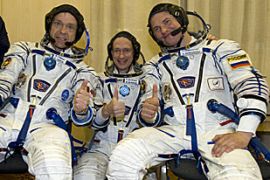Launch to double space station crew
Russian spacecraft lifts off with three more astronauts to man International Space Station.

‘Incredible things’
The incoming crew will join Gennady Padalka, a Russian; Michael Barratt, an American; and Koichi Wakata, a Japanese citizen.
Friday’s docking will mark the first time all the partners in the station – the US, Russia, Europe, Japan and Canada – will be represented at the same time on board.
Shortly before his departure from the Baikonur cosmodrome, De Winne said: “It’s a very good example that shows the whole world that when countries want to work together for the good of their children we can do incredible things.
“It would be impossible for one country to maintain six people aboard the space station.
“But thanks to the international co-operation, not just aboard the ISS but between all the space organisations, it will be possible.”
Sophisticated platform
The European Space Agency now receives 8.3 per cent of the experiment time aboard the ISS, meaning that it can send an astronaut to the station for a six-month mission every two years.
De Winne will take over from Padalka as commander of the ISS when the crew is rotated in October, the first time a West European has been given this responsibility.
The Belgian will then return to earth in November.
The station has become a sophisticated platform for scientific experiments after the installation of a European laboratory last year and the arrival of a hi-tech Japanese lab, Kibo, which is currently being completed.
A huge new solar array was installed earlier this year to give more power.
Amid an array of new technology, one feature new arrivals will have to get used to is a facility installed this month that enables astronauts to drink their recycled urine.
In one study to be carried out on the station, Thirsk, 55, will take medication usually prescribed to geriatric patients to counter the effects of bone loss in space.